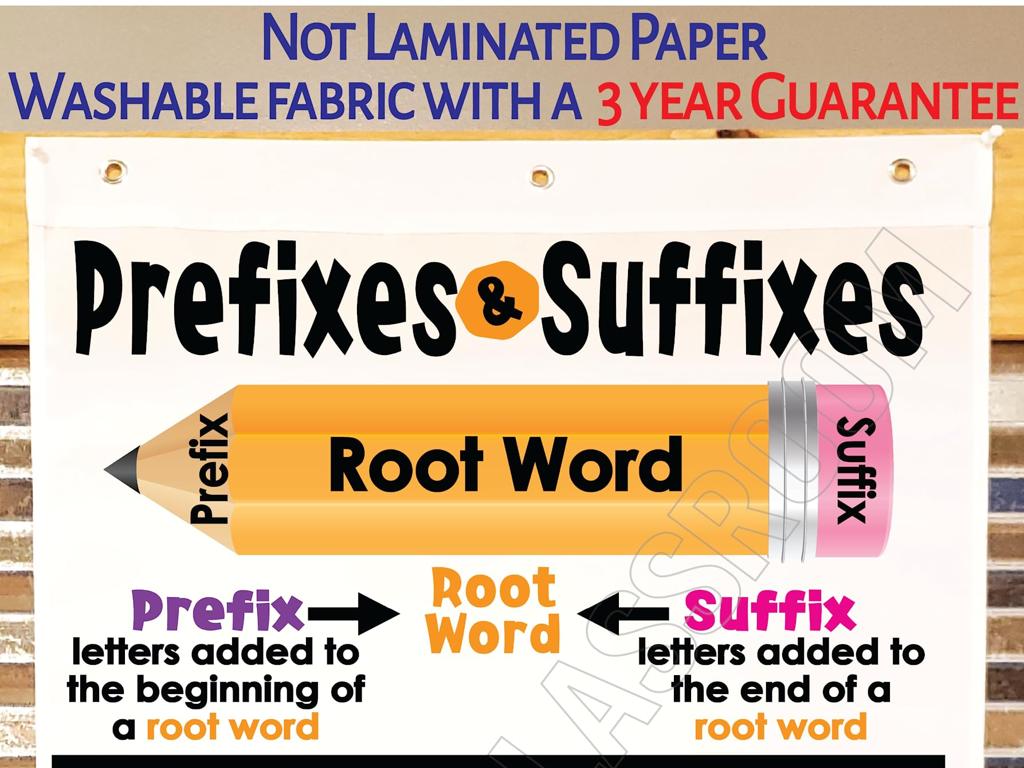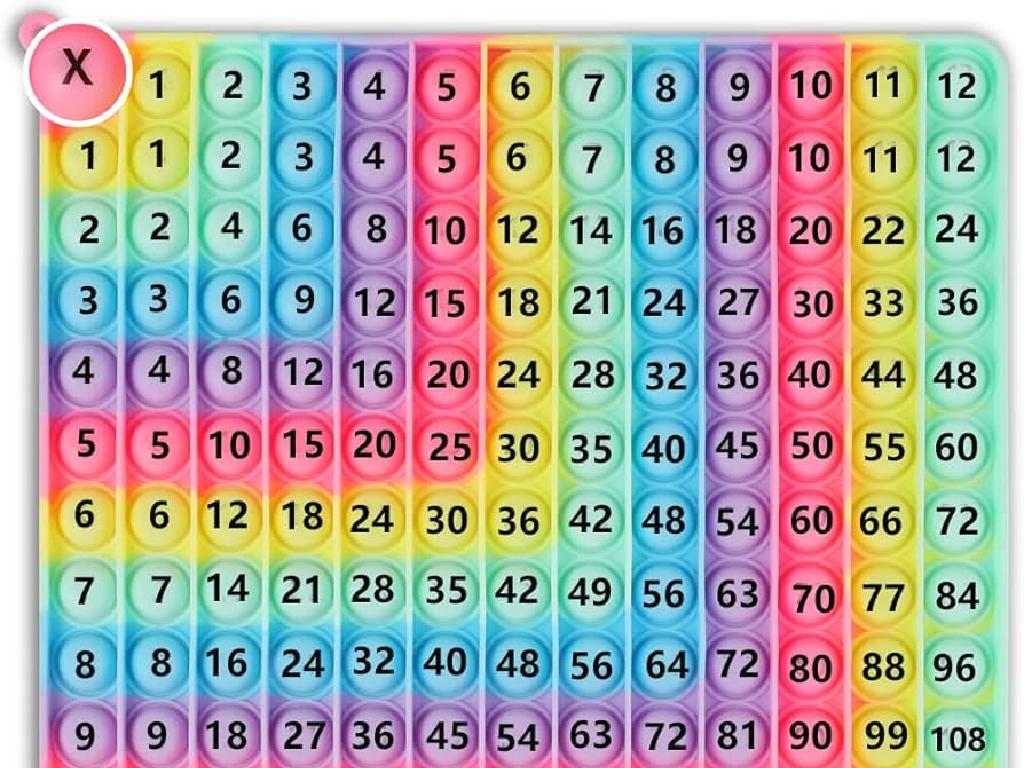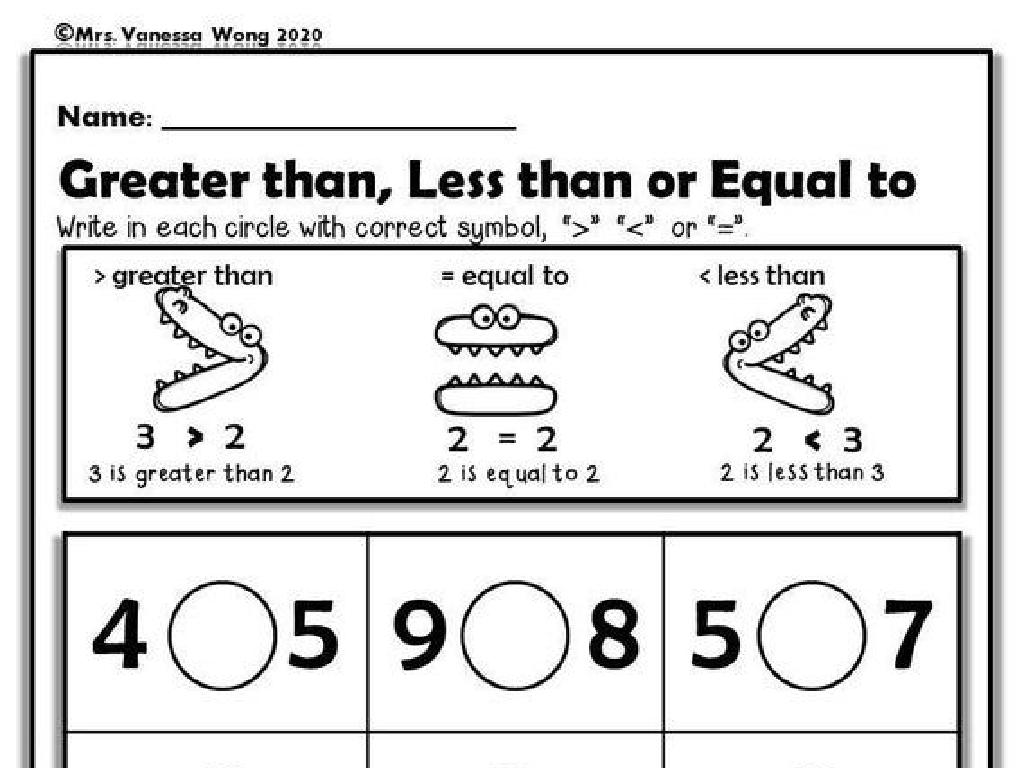Compare Fractions: Word Problems
Subject: Math
Grade: Seventh grade
Topic: Fractions
Please LOG IN to download the presentation. Access is available to registered users only.
View More Content
Comparing Fractions: Real-Life Word Problems
– Understanding fractions as parts
– Imagine a pizza cut into equal slices, each slice is a fraction of the pizza.
– Today’s focus: Fraction comparison
– Use word problems to compare different fractions.
– Real-life scenarios for practice
– Examples: Comparing slices of pizza or sharing a chocolate bar.
– Objective: Identify larger/smaller fractions
– Learn techniques to decide if 1/2 is greater than 1/3 and apply this in various contexts.
|
This slide introduces the concept of comparing fractions through the context of word problems, which are relatable to real-life scenarios. Students will understand fractions as parts of a whole, such as slices of a pizza, and will learn to determine which fraction represents a larger or smaller part. The objective is to equip students with the skills to analyze and compare fractions in situations they might encounter outside of the classroom. Encourage students to visualize the fractions in terms of everyday items to better grasp the concept. Provide examples and guide them through the process of comparing fractions by finding common denominators or using benchmarks like 1/2.
Review of Fractions: Understanding the Basics
– Recap: Definition of a fraction
– A fraction represents a part of a whole
– Numerator vs. Denominator
– Top number (numerator) and bottom number (denominator) roles
– Visualizing simple fractions
– Examples: 1/2 of a pizza, 3/4 of an hour
– Solving fraction word problems
– Apply knowledge to real-world scenarios
|
Begin with a quick review of what a fraction is, emphasizing that it represents a part of a whole. Clarify the roles of the numerator and denominator, with the numerator indicating how many parts we have and the denominator showing the total number of equal parts in the whole. Use visual aids like pie charts or bar models to illustrate simple fractions such as 1/2 or 3/4, which can help students better grasp the concept. Finally, introduce word problems that involve fractions to show practical applications of the concept. Encourage students to visualize the problems and to express the situations using fractions. This will set the stage for comparing fractions in subsequent lessons.
Understanding Equivalent Fractions
– Define equivalent fractions
– Fractions that have the same value, even if they look different
– Methods to find equivalents
– Multiply or divide the numerator and denominator by the same number
– Practice with examples
– Example: 1/2 is equivalent to 2/4, 3/6, 4/8
– Class activity: Identify equivalents
|
This slide introduces the concept of equivalent fractions, which are different fractions that represent the same part of a whole. Start by defining equivalent fractions and then explain the methods to find them, such as multiplying or dividing the numerator and denominator by the same number. Provide practice examples for students to work through, such as finding fractions equivalent to 1/2. For the class activity, have students identify sets of equivalent fractions from a list you provide. This will help solidify their understanding through hands-on practice. Possible activities could include creating visual fraction models, using fraction strips, or playing matching games with equivalent fractions.
Comparing Fractions: Word Problems
– Steps to compare fractions
– Find a common denominator or cross-multiply to compare
– Common denominator method
– Make denominators the same, then compare numerators
– Cross-multiplication technique
– Multiply across the fractions to compare values
– Practice with word problems
– Solve real-life problems by applying these methods
|
This slide introduces students to the concept of comparing fractions through word problems. Start by explaining the two primary methods: finding a common denominator and cross-multiplication. Emphasize that the common denominator method involves making the denominators the same so that the numerators can be directly compared. For the cross-multiplication method, teach students how to multiply diagonally across the fractions and compare the resulting products. Provide examples of word problems where these methods can be applied, and encourage students to practice with additional problems to solidify their understanding. Ensure that students grasp that these methods are tools to help solve practical problems involving fractions.
Comparing Fractions: Word Problems
– Comprehend the problem statement
– Read carefully to grasp what’s being asked
– Visualize with fraction models
– Draw pie charts or number lines to illustrate
– Apply comparison strategies
– Use cross-multiplication or common denominators
– Practice with real-world examples
– Use examples like pizza slices or measuring cups
|
This slide is aimed at providing students with a structured approach to solving word problems involving fraction comparison. Start by ensuring they understand the problem by reading it multiple times and identifying key information. Encourage them to visualize the problem using models such as pie charts or number lines, which can make abstract concepts more concrete. Teach them strategies like finding common denominators or cross-multiplication to compare fractions effectively. Finally, use relatable examples such as comparing portions of pizza or amounts in measuring cups to demonstrate these concepts in a context familiar to them. The goal is to build their confidence in tackling fraction word problems by breaking down the process into manageable steps.
Comparing Fractions: Word Problems
– Recipe ingredient comparison
– Which recipe uses more sugar: 1/2 cup or 3/8 cup?
– Analyzing race results
– Who finished faster, the runner with 3/4 or 5/8 of the lap left?
– Time allocation for activities
– How to divide 3 hours between homework (1/2) and play (1/4)?
|
This slide presents real-world applications of comparing fractions through word problems. For recipe ingredients, students will compare different fraction amounts to determine which recipe requires more of an ingredient. In determining race winners, they will analyze fractions representing parts of a race completed to identify the winner. When allocating time for activities, students will use their knowledge of fractions to divide a set amount of time between different tasks. Encourage students to visualize these scenarios and use fraction comparison strategies like finding common denominators or converting to decimals for easier comparison. Provide additional practice problems for each scenario to reinforce the concepts.
Class Activity: Fraction Skits
– Divide into small groups
– Receive a fraction word problem
– Each group gets a unique problem involving comparing fractions
– Create and act out a skit
– Use props and dialogue to illustrate the fractions in the problem
– Present problem and solution
– Conclude your skit by explaining the solution to the class
|
This interactive class activity is designed to help students understand fractions through creative expression. By dividing the class into small groups, each group will work collaboratively to understand their assigned word problem. They will then create a skit that acts out the scenario presented in the problem, using props and dialogue to bring the concept of comparing fractions to life. The skit should end with the group presenting their solution to the problem, demonstrating their understanding of the concept. Possible activities could include comparing fractions in recipes, sharing items among friends, or measuring items. This activity will help students visualize and internalize the process of comparing fractions in a fun and engaging way.
Conclusion & Homework: Mastering Fractions
– Recap of fraction comparison
– Relevance to daily life
– Fractions are everywhere: cooking, budgeting, time management
– Homework: 5 word problems
– Solve problems, show work, and explain reasoning
– Practice makes perfect
|
As we conclude today’s lesson on comparing fractions through word problems, it’s crucial to emphasize the practical application of these skills in everyday life, such as in recipes or dividing resources. For homework, students are assigned 5 additional problems to reinforce their understanding. Encourage them to not only find the answers but also to write down their problem-solving process. This practice will help solidify the concepts learned in class and improve their critical thinking skills. In the next class, we can review these problems to address any challenges students may have encountered.






